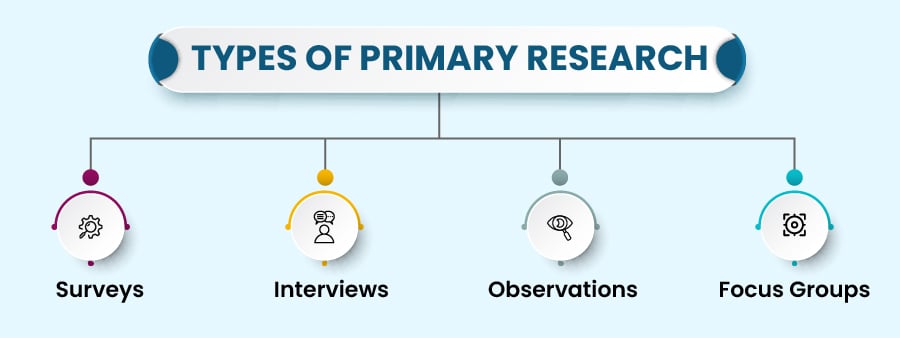What It is, Advantages, Methods & Examples
Through this informative blog, you will get to know the meaning of primary research, types, and more.
Through this informative blog, you will get to know the meaning of primary research, types, and more.
Table of Content
While researching one of the first thoughts that might come to your mind is where to start from. You might also be thinking, what if it's just not good enough? Take it easy! Definitely, you are not the only one who feels. We have all been there, and it's normal. Therefore, are you feeling stuck or struggling with your primary research? We've got your back! This blog will help you solve all your queries. Moreover, in this, we will discuss about primary research, its advantages, examples, and various research methods. Now, next we look into what primary research is? So, without any further delay, you can read this blog to expand your knowledge.
Whenever you hear primary research, what is the first thing that comes to your mind? Are you confused or feeling stuck on where to begin? You are not in this alone. According to Wikipedia, primary research is regarded as a research methods that depends on direct collection. It does not rely on data that has already been gathered by others. However, if you want to know why it is essential, then you can read this below sections. This blog will help you learn its advantages and various primary research methods. What are you waiting for? Let's dive into some of its benefits. Scroll below to learn more!
Do you know that there are various advantages of primary research? No? Don't stress! In this section of the blog, we are going to discuss about this to increase your knowledge.
These were some of the advantages of primary research that you read above. Up next, we will explore some of the disadvantages of primary research.
As you may know, everything comes with both advantages and disadvantages. So does primary research. It also consists of various disadvantages, which we are going to talk about in the next section of this blog.
Time: It takes a lot of time, from planning to moving through collecting data and figuring out what it all means. This may not be suitable if you are working with a tight deadline. Hence, this slower process might not be the best fit.
Cost: Primary research can get pretty expensive. From creating the study and finding the right people to take part to gathering and analysing all the data. These expenses can be restrictive and can be hard to manage.
Bias: Even with the best efforts to keep things balanced, primary research is vulnerable to bias—whether it comes from the researcher, participants, or research content itself. Therefore, these biases can make it harder to get truly accurate results.
Complexity: Designing and conducting primary research is not always easy. It takes a certain level of skills to make sure the data you collect is accurate and reliable. Thus, it can be challenging, especially when you are a beginner.
Sample Size & Representativeness: Getting a sample size that is both big and reflects the larger group you are studying can be tricky. If it's not done right, then it can lead to results that might not be reliable.
So, as we have mentioned above, these were some of the disadvantages of primary research. Whenever you feel stuck with your research topics, you can ask experts, ”Can you write my research topic for me?” They will assist you in the best possible way. Now, are you ready to shift to the below section? Let's dive into some of the diverse primary research methods.
As a student, are you facing challenges in choosing an appropriate research method or understanding the implications of your data? You know the best part? In this section of the blog, we will see different primary research methods that can resolve all your data collection issues. Below are some types mentioned.

Surveys are a useful way to collect information from a specific group of people. It is a set of organised questions in the form of a questionnaire. Thus, it will enable you to understand things like preferences, opinions, and behaviour. It can take place online, in person, or through the mail.
Interviews are one type of primary data collection method. It involves talking one-on-one with someone to comprehend their thoughts and experiences in more detail. Hence, it is a great way to dig deeper into complex topics, hear different perspectives, and gather personal insights.
Observation refers to carefully watching and observing the behaviour of the people and how things happen in real life. There are three types of observational study: cross-sectional, case-control, and cohort studies. All three are simple and easy to design. Hence, it helps you gain insight into complex situations.
Well, focus groups involve talking through ideas with a small group to hear different opinions. Further, it enables you to understand how people feel about a topic. It is excellent for seeing how people interact and brainstorm new ideas together. In this, a moderator guides the discussion and encourages participants to share their opinions.
As we have discussed, these were various types of primary data collection methods. Further, let's move to the next section. The below section will help you understand the differentiation between primary and secondary research.
Do you want to know the difference between primary vs secondary research? Here we go! Below is the explanation ready in a tabular format.
|
Features |
Primary Research |
Secondary Research |
|
Data Source |
Original data gathered by you |
Using data that's already out there |
|
Data Collection |
Fresh information gathered from various methods |
Analysis of existing data |
|
Time & Cost |
Takes time, efforts and money |
Less-time consuming and expensive |
|
Purpose |
Answer specific research question |
Gives you bigger picture first and context |
So, this was the brief description of primary vs secondary research. Now. next we are going to see some of it's examples.
Are you also struggling to find examples of primary research methods? Don't worry! In this section, we will cover some examples. Discover more information below.
So, these are some of the diverse examples of primary research methods that can help you understand which method suits which kind of research question.
According to Wikipedia, primary research is a powerful tool for you to study topics firsthand and develop original insights. We have discussed four methods of primary research, their advantages and disadvantages, and various examples. Moreover, this blog can also help you find various business research topics. However, if you still feel stuck in choosing the correct method for your research, experts at the Assignment Desk will help you in solving these problems. Also, they will provide you with up-to-date and relevant sources for your research study.

Get an Extra 5% OFF On Your Order in Our App

Scan the QR code with your mobile to unlock an exclusive offer!
Download App Now Scan me
Scan meNo matter whether you are a student or a researcher or looking to gather primary data for a dissertation, essay, or any other project, we are here for your help. However, if you need assistance in designing surveys or interviews, seek assignment help. Our experts will help you to know more about primary data collection. Additionally, they will assist you in refining broad ideas into focused and researchable questions.
Boost Grades & Leave Stress
Get A+ Within Your Budget!
Use Our FREE TOOLS !
It involves collecting original data directly from sources to examine a research question rather than relying on existing information.
It offers several advantages, including the ability to collect up-to-date and highly relevant data and more in-depth insights into specific search questions.
You may know that primary research involves collecting new and original data through methods like surveys and interviews. Whereas, secondary research utilises existing data that has already been collected and analyzed by others.
You should use primary research when you need original data or firsthand accounts or when exploring a topic with limited existing research. .
Limited Time Offer
Exclusive Library Membership + FREE Wallet Balance
1 Month Access !
5000 Student Samples
+10,000 Answers by Experts
Get $300 Now
Update your Number
